05 October – 30 November, 2013
Several weeks after the exhibition closed for the 4th International Artist’s Book Prize and it still feels a bit like clearing up after a great party – lots of really great reasons for having done it and doubts amongst the debris as to the wisdom of the whole event and whether it should ever be repeated – did we invite too many people, did we try too hard to appeal to all, did we stick too rigidly to plans that should have changed as the size of the whole thing became apparent?
Some things about the intentions and aims of the Prize have been there since before its inauguration – open access, visitors acting as jury to create a ‘dialogue’ with the books, the promise to show all entries in the exhibition…. and these things have seemed sacrosant. Other elements we have added or altered as the Prize has grown over the last few years – a printed catalogue containing all entries, Jury awarded Prizes, increased Prize money, a growing Collection of books. “Plus ça change, plus c’est la même chose.” And in some ways that proverb holds true – but in some ways not.
We had pushed the boat out a little in 2013, having secured both funding and sponsorship for the first time, with the intent of increasing both awareness and participation. As such we were able to do some additional marketing during the Call for Submissions with the result that entries increased threefold over the previous edition. However, this increase was not easy to anticipate – well over two thirds of entries arrived in the last month – up until June we had no idea how many books we were likely to get and so no possibility of thinking early how to adapt. I had a contingency if entries got up to six hundred – I had elected to stage the show for eight weeks this time around and so I knew I could always show half of the books for three weeks and the other half for three weeks more and then put those with the most votes together for the final two weeks. Not ideal, but possible.
As it transpired, we received 455 entries – probably not enough to require staging in two separate shows but certainly a challenge just to fit them all into the galleries – not to mention the challenge for visitors to actually see all of the books or even find their way around. Mocking up the books for display in studios and galleries we were able to calculate the number of meters needed to show each book in its own space without overlap and obscuring books – the first time I have ever had to plan a show by linear meterage. Using purpose built shelving, designed in such a way to ensure it did not look like a shop we were able to plan the layout of three of the gallery spaces. I felt all galleries laid out exactly the same, with so many books, would be overwhelming…
…so we opted to use a mixture of shelving and boxes to display the books to create variety. There is no doubt the galleries felt full – cluttered even – but we needed to put in tables and chairs to allow books to be studied at leisure and we also added plinths to deal with the many oversize books.
A quick calculation suggested that if visitors looked at each book for 10 seconds it would take around 6 hours to view them all – this certainly questioned the wisdom of showing all books – but equally, it was important to honour the commitment to do so when that was the basis of the Call for Submissions. We had only a few days between final entries coming in and judging the books and only a month between close of entries and sending the catalogue off to press. These deadlines necessitated rapid decision making in terms of staging and catalogue design that we will certainly review – although, in general, reaction to both the exhibition and accompanying catalogue was extremely positive.
One of the decisions we took was to estimate how many books would fit into the main gallery and ask the Jury to make a selection for that space. Around 130 books were shown in the main Central space with all others on display in the 4 satellite spaces. We made no great show of this distinction (and indeed two of the books that did well in the public vote were not part of this Jury selection) but invigilators were encouraged to point out to visitors short of time that they may like to start in the main gallery.
So, close inspection of all books was clearly a problem. Undoubtedly, adding a catalogue helped ensure all books figured equally. Furthermore, with around ninety per cent of those who entered donating their books to our Collection we will be able to take the opportunity in the months ahead of showing smaller selections of the books in themed exhibitions and giving visitors the chance to look more closely at books they may well not even have seen in one visit.
As ever with the Book Prize, some visitors spent many hours in the Centre and many people came back more than once during the two months of the show. Visitor numbers exceeded twelve hundred and over a thousand people voted for their favourite. The books selected by visitors were also different from those selected by the Jury and over the weeks there was a fair degree of unanimity in where votes were cast.
In another departure in 2013, we also organised (in conjunction with The University of Sheffield) a Symposium, a series of workshops, talks, performances and smaller exhibitions alongside the Book Prize. All were well attended. Books from the Collection were shown in hotels and libraries around the city as well as a city centre shop window, increasing those who saw some aspect of the prize to many thousands.
The entries themselves reflected the diversity of the artist’s book world. From tiny books in match boxes to huge wall hangings, books made from metal, porcelain, wood and sandpaper, entries from thirty five different countries and whilst we didn’t ask about age, one from a thirteen year old school student. Visitors to the exhibition did comment on being enthralled by the range and diversity and out not defining what constitutes a book certainly adds an element of surprise and pleasure to both those discovering artists books for the first time and those more familiar with the medium.
And so back to that clearing up… Most books have now been returned to those requesting returns. Many of those that form part of our Collection are now catalogued online (though there is a lot of work still to do on indexing and proof reading). We have yet to begin the process of following up this year’s event in terms of research from both audience and participants’ perspective. But thanks to all those who did take part, I think we achieved our objective of making the Prize a significant event in the artist’s book calendar and we look forward to the winners exhibitions in the year ahead.
John Clark
Bank Street Arts
January 2014
Looking back on the 2013 Prize, I am not sure which was tougher – attempting to choose a winner out of 455 entries or carrying through with our commitment to exhibit them all. The scale of the event took us by surprise. We had hoped for a continued increase in the number of submissions and that the high quality of entries seen in previous years would also be maintained but I don’t think we had expected either the volume or quality that we witnessed. The judging, which took place in early August was exceptionally difficult and resulted in us making a selection of over 130 books, any one of which could have made the final cut in the eyes of one of the panel. A shortlist of 25 was whittled down to 8 and at that point it became something of a lottery.
The final eight were as follows:
What to do / Wat te doen by Bas Fontein (The Netherlands – joint winner);
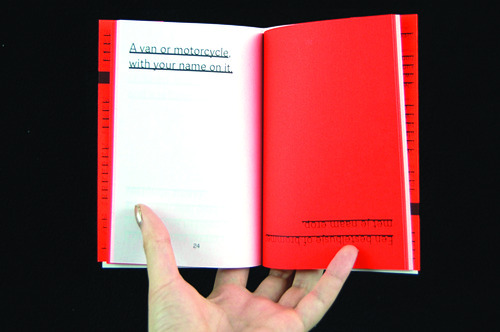
tea and water pipe by Erin K Schmidt (USA – joint winner);
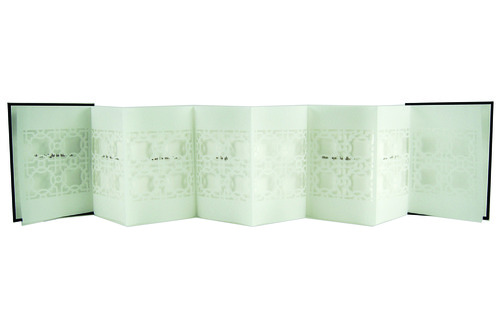
Correspondance by Radoslaw Nowakowski & Venantius J. Pinto (Poland/India – joint runner-up);

Made to Please/Damaged Goods by Yvonne Jones (UK – joint runner-up);
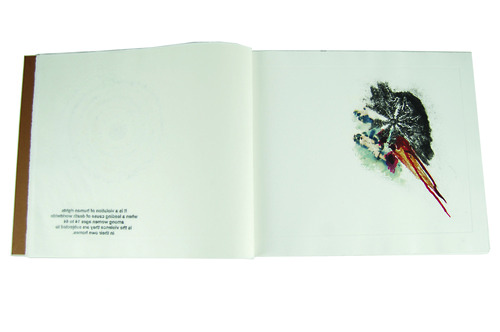
10-Euro Outfits by Hans Eijkelboom (The Netherlands);

Mazdaznan Health and Breath Culture by Ian Whittlesea (UK);

Over the Hill by Nick Rands (UK);

Old Mother Hubbard in Venice by Paul Johnson (UK).

The other books on the shortlist were: Nicolas Davis, d P1sUR of d Txt; Lars Wilktrom, Okentecken (Desert Signs); Mischa Bjorkroos, Fjodor 1; Hilla Rost, Die Stille (The Silence); Mette-Sophie Ambeck, Al-Mutanabbi Street – A Vicious Circle; Jesvin Yeo, Jackson Pollock in Typography Garden; Joanna Robson, Jeckyll and Hyde; Dunchan Bullen and Jamie Crofts, Chromatic Fields; Guy Bigland, All the Four Letter Words That are Sometimes Used With Other Four Letter Words (That I Can Think of); Lucas Kunz, Radiograms; Ellis Murphy, Rollcall; Sandra Turley, This Original Self; Candace Hicks, Common Threads Volume XL VIII; Rob Cheung, The Big Bang Theory plus the three student entries below.
We had similar problems judging the Student Prize – with over 120 entries for this alone, of which more than 30 made the final jury selection. Winners of the Student Prize were as follows:
The Great Fire of Eydon by Isla Millar (UK – Student Prize Winner);
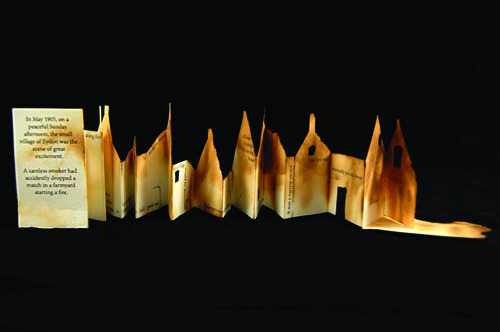
God Created the Sea and Painted it Blue so We Feel Good on it by Michelle Ray (USA – Student Prize Runner-up);
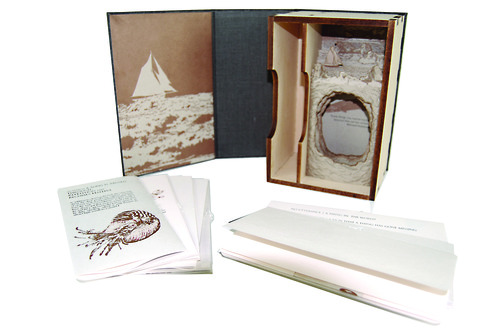
Pocket Orrery by Alex Pritchard (UK) third in Student Prize.


